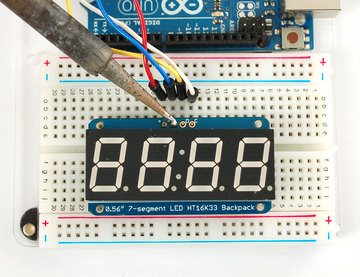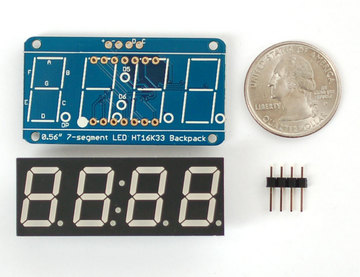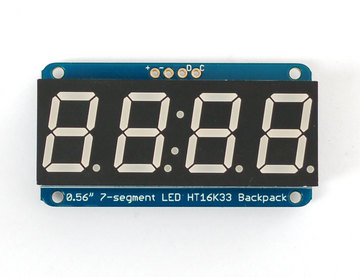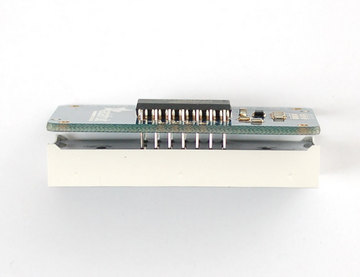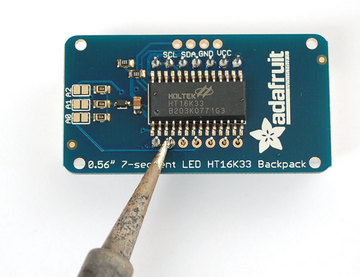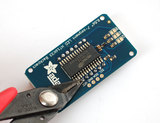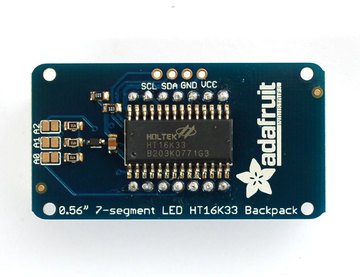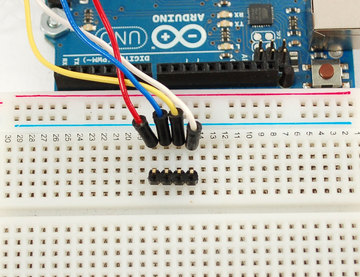Différences entre versions de « ADF-LED-BACKPACK-7-Segments »
| Ligne 23 : | Ligne 23 : | ||
{{asm-text}} Solder all 14 pins. | {{asm-text}} Solder all 14 pins. | ||
| + | {{asm-img|img=ADF-LED-BACKPACK-7SEG-06.jpg}} | ||
{{asm-row|img=ADF-LED-BACKPACK-7SEG-05.jpg}} | {{asm-row|img=ADF-LED-BACKPACK-7SEG-05.jpg}} | ||
| − | |||
| − | |||
{{asm-text}} Clip the long pins. | {{asm-text}} Clip the long pins. | ||
Version du 3 février 2013 à 19:57
|
|
En cours de traduction/élaboration. |
This version of the LED backpack is designed for these big bright 7-segment displays. These 7-segment displays normally require 13 pins (5 'characters' and 8 total segments each) This backpack solves the annoyance of using 13 pins or a bunch of chips by having an I2C constant-current matrix controller sit neatly on the back of the PCB. The controller chip takes care of everything, drawing all the LEDs in the background. All you have to do is write data to it using the 2-pin I2C interface. There are two address select pins so you can select one of 8 addresses to control up to 8 of these on a single 2-pin I2C bus (as well as whatever other I2C chips or sensors you like). The driver chip can 'dim' the entire display from 1/16 brightness up to full brightness in 1/16th steps. It cannot dim individual LEDs, only the entire display at once.
That's it! now you're ready to run the firmware!
Seven-Segment Backpack Firmware
We wrote a basic library to help you work with the 7-segment backpack. The library is written for the Arduino and will work with any Arduino as it just uses the I2C pins. The code is very portable and can be easily adapted to any I2C-capable micro.'
Wiring to the matrix is really easy
- Connect CLK to the I2C clock - on Arduino UNO thats Analog #5, on the Leonardo its Digital #3, on the Mega its digital #21
- Connect DAT to the I2C data - on Arduino UNO thats Analog #4, on the Leonardo its Digital #2, on the Mega its digital #20
- Connect GND to common ground
- Connect VCC+ to power - 5V is best but 3V also seems to work for 3V microcontrollers.
Next, download the Adafruit LED Backpack library from github . To download click the DOWNLOADS button in the top right corner, rename the uncompressed folder Adafruit_LEDBackpack. Check that the Adafruit_LEDBackpack folder contains Adafruit_LEDBackpack.cpp and Adafruit_LEDBackpack.h Place the Adafruit_LEDBackpack library folder your arduinosketchfolder/libraries/ folder. You may need to create the libraries subfolder if its your first library. [https://github.com/adafruit/Adafruit-GFX-Library You'll also need to download the Adafruit GFX library - rename it and install it as the LED backpack library. Its not actually used for the 7-segment, its only for the matrix backpacks but its still required. Restart the IDE.
Once you've restarted you should be able to select the File > Examples > Adafruit_LEDBackpack > sevenseg example sketch. Upload it to your Arduino as usual. You should see a basic test program that goes through a bunch of different routines.
Once you're happy that the matrix works, you can write your own sketches.
There's a few ways you can draw to the display. The easiest is to just call print - just like you do with Serial
- print(variable,HEX) - this will print a hexidecimal number, from 0000 up to FFFF
- print(variable,DEC) or print(variable) - this will print a decimal integer, from 0000 up to 9999
If you need more control, you can call writeDigitNum(location, number) - this will write the number (0-9) to a single location. Location #0 is all the way to the left, location #2 is the colon dots so you probably want to skip it, location #4 is all the way to the right. If you want a decimal point, call writeDigitNum(location, number, true) which will paint the decimal point. To draw the colon, use drawColon(true or false)
If you wnat even more control, you can call writeDigitRaw(location,bitmask) to draw a raw 8-bit mask (as stored in a uint8_t) to that location.
All the drawing routines only change the display memory kept by the Arduino. Don't forget to call writeDisplay() after drawing to 'save' the memory out to the matrix via I2C.
There are also a few small routines that are special to the backpack:
- setBrightness(brighness)- will let you change the overall brightness of the entire display. 0 is least bright, 15 is brightest and is what is initialized by the display when you start
- blinkRate(rate) - You can blink the entire display. 0 is no blinking. 1, 2 or 3 is for display blinking.
Source: Control small led matrice with ease créé par LadyAda pour AdaFruit Industries. Crédit AdaFruit Industries
Traduit avec l'autorisation d'AdaFruit Industries - Translated with the permission from Adafruit Industries - www.adafruit.com
Toute référence, mention ou extrait de cette traduction doit être explicitement accompagné du texte suivant : « Traduction par MCHobby (www.MCHobby.be) - Vente de kit et composants » avec un lien vers la source (donc cette page) et ce quelque soit le média utilisé.
L'utilisation commercial de la traduction (texte) et/ou réalisation, même partielle, pourrait être soumis à redevance. Dans tous les cas de figures, vous devez également obtenir l'accord du(des) détenteur initial des droits. Celui de MC Hobby s'arrêtant au travail de traduction proprement dit.
